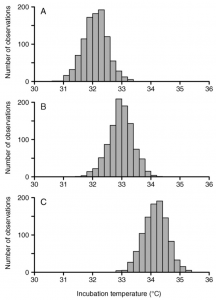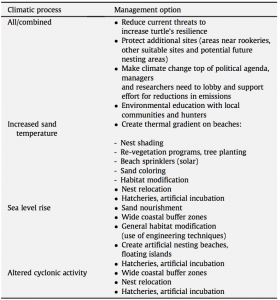Implications of climate change for the sex ratios of sea turtle hatchlings
By Grace Roskar, SRC Intern
Sea turtles have existed on Earth for over 100 million years and presently inhabit warm waters in tropical and subtropical latitudes. The International Union for the Conservation of Nature has classified six of the seven species of sea turtles as critically endangered, endangered or vulnerable (IUCN, 2014 in Laloë et al., 2016). Threats to sea turtles include being taken as bycatch from fishing, poaching of eggs, and destruction of their habitats on land or at sea. Moreover, all sea turtle species come ashore to lay their eggs on sandy beaches, but these critical habitats face changes in air, water, and sand temperatures and rising sea levels (Santos et al., 2015). These climatic impacts occur at varying timescales and in different geographic locations, which makes it more challenging to respond to and mitigate these various threats (Fuentes and Cinner, 2010).
Like many reptiles, sea turtles possess temperature-dependent sex determination (TSD), which means that the incubation temperature of eggs in the nest determines the sex of an individual. Each species has a certain threshold, or pivotal, temperature, where equal numbers of males and females are produced. Temperatures below this pivotal temperature produce males whiles temperatures above produce females (Standora and Spotila, 1985). The determination of sex occurs in the middle third timeframe of the development of the embryo (Tapilatu and Ballamu, 2015). Due to TSD, increasing temperatures are a concern to sea turtles and were recently determined to be one of the largest threats to sea turtle populations (Fuentes and Cinner, 2010). Sex ratios could become skewed, and in more extreme cases, local extinctions could occur (Janzen, 1994 in Laloë et al., 2016). Warmer nest temperatures may lead to a greater majority of female hatchlings (Howard, Bell and Pike, 2015). Determining what ways increasing temperatures can impact populations is a priority for the conservation of sea turtles (Laloë et al., 2016).
In one study, Fuentes and Cinner (2010) used the knowledge of sea turtle experts to estimate how increasing temperatures and other climatic processes will impact sea turtles’ reproductive phases. The turtles of interest were green turtle (Chelonia mydas) populations in the northern Great Barrier Reef of Australia. Twenty-two scientists and managers were surveyed, and both groups agreed that higher sand temperatures could be considered the biggest threat to the reproductive output of these populations. The experts believe that higher sand temperatures will cause “two times more impact to sea turtles’ reproductive output than sea level rise and three times more impacts than altered cyclonic activity” (Fuentes and Cinner, 2010).
However, studies have also showed certain levels of resilience in some sea turtle populations. Howard, Bell, and Pike (2015) studied flatback sea turtles (Natator depressus) that are only native to Australia. Eggs were incubated in a laboratory to examine if the population was vulnerable to higher temperatures while nesting. The eggs were collected from beaches in northeastern Australia, and thus their pivotal temperatures were compared to those of populations from more temperate latitudes in Australia. It was found that the embryos in their study were resilient to incubation at high temperature, able to withstand temperatures almost 4°C above those from more southern populations. Moreover, the pivotal sex-determining temperature was different from past studies. It was previously thought that 29.5°C would produce an equal sex ratio, but for the eggs in this study, 30.4°C was the pivotal temperature. With a higher pivotal temperature, increasing environmental temperatures could drive the sex ratios closer towards equality. Therefore, even under extreme climate change scenarios, this high pivotal temperature adaptation may allow some flatback turtle populations to still produce more equal sex ratios (Howard, Bell, and Pike, 2015).
Not all sea turtle populations have shown such resilience. Fuentes, Hamann, and Limpus (2010) studied sand and air temperatures in the northern Great Barrier Reef. By using models and projections, it was estimated that by 2030, the sex ratios of hatchlings will be greatly skewed towards females. This has also been predicted for other nesting sites such as Cape Canaveral, Florida, and Bald Head Island, North Carolina (Hawkes et al 2007 in Fuentes, Hamann, and Limpus 2010). Laloë et al. (2016) examined historical data for incubation temperatures and sex ratios for green, hawksbill (Eretmochelys imbricata), and leatherback (Dermochelys coriacea) turtles nesting in St. Eustatius in the northeastern Caribbean. Their analysis suggested sex ratios have been skewed towards females for decades, and climate change will only intensify this. It was projected that in St. Eustatius “only 2.4% of green turtle hatchlings will be males by 2030, 1.0% by 2060, and 0.4% by 2090,” (Laloë et al., 2016). Sex ratios dominated by females have already been reported at nesting sites around the world (e.g. Barbados, Cyprus) and at certain sites, some ratios are as high as 100% female (Binckley et al., 1998 in Laloë et al., 2016).

Projections of increasing incubation temperatures at one site in St. Eustatius. Graph A shows projections for 2030, graph B shows 2060, and graph C shows 2090 (Laloë et al., 2016).
Sea turtles have existed for millions of years and have previously shown the ability to adapt during periods of sea level rise and temperature changes, such as changing nesting site locations or utilizing new migratory paths (Fuentes, Hamman, and Limpus 2010). However, modern-day changes in climate have been predicted to occur at a much faster timescale than past changes. Therefore, the capabilities of sea turtles adapting to these changes are still fairly unknown (Fuentes, Hamman, and Limpus 2010). There are several management options that have been suggested in order to mitigate the effects of higher temperatures. Some active methods include artificially changing the sand temperature by sprinkling cool water on the sand, covering areas of the beach with vegetation, or creating artificial shade (Naro-Maciel et al., 1999 in Fuentes, Hamman, and Limpus 2010). Other methods include the use of hatcheries and artificial incubation where temperatures can be controlled, but there is still uncertainty about the risks associated with changing natural sex ratios. Management could also be aimed at population-wide measures, including protecting key habitats, reducing bycatch of sea turtles, and preventing illegal harvest (Fuentes and Cinner, 2010).

A table outlining possible management measures to reduce climate change impacts on sea turtle reproduction, provided by experts surveyed in the study by Fuentes and Cinner (2010).
Sea turtles have key roles in the ecological function of marine ecosystems, as they help maintain seagrass beds and are a valuable part of the tourism industry for many nations. It is vital to understand how the changing environment will influence risks for current and future sea turtle populations around the world. Minimizing further anthropogenic impacts, conserving existing populations and habitats, and further investigation of sea turtles’ ability to adapt to increasing temperatures is critical to protecting these marine organisms.
References:
Howard, Robert, Ian Bell, and David Pike. “Tropical Flatback Turtle (Natator Depressus) Embryos Are Resilient to the Heat of Climate Change.” Journal of Experimental Biology 218 (2015): 3330-335. Web. 1 Feb. 2016.
Fuentes, M.M.P.B., and J.E. Cinner. “Using Expert Opinion to Prioritize Impacts of Climate Change on Sea Turtle’s Nesting Grounds.” Journal of Environmental Management 91 (2010): 2511-518. Web. 1 Feb. 2016.
Laloë, Jacques-Olivier, Nicole Esteban, Jessica Berkel, and Graeme Hays. “Sand Temperatures for Nesting Sea Turtles in the Caribbean: Implications for Hatchling Sex Ratios in the Face of Climate Change.” Journal of Experimental Marine Biology and Ecology 474 (2016): 92-99. Web. 1 Feb. 2016.
M.M.P.B. Fuentes, M. Hamann, and C.J. Limpus. “Past, Current and Future Thermal Profiles of Green Turtle Nesting Grounds: Implications from Climate Chang.” Journal of Experimental Marine Biology and Ecology 383 (2010): 56-54. Web. 1 Feb. 2016.
Santos, Katherine Comer, Marielle Livesey, Marianne Fish, and Armando Camago Lorences. “Climate Change Implications for the Nest Site Selection Process and Subsequent Hatching Success of a Green Turtle Population.” Original Article Mitigation and Adaptation Strategies for Global Change (2015): n. pag. Web. 1 Feb. 2016.
Standora, Edward A., and James R. Spotila. “Temperature Dependent Sex Determination in Sea Turtles.” Copeia 1985 (1985): 711-22. Web. 1 Feb. 2016.
Tapilatu, Ricardo F., and Ferdiel Ballamu. “Nest Temperatures of the Piai and Sayang Islands Green Turtle (Chelonia Mydas) Rookeries, Raja Ampat Papua, Indonesia: Implications for Hatchling Sex Ratios.” Biodiversitas 1st ser. 16 (2015): 102-07. Web. 1 Feb. 2016.
